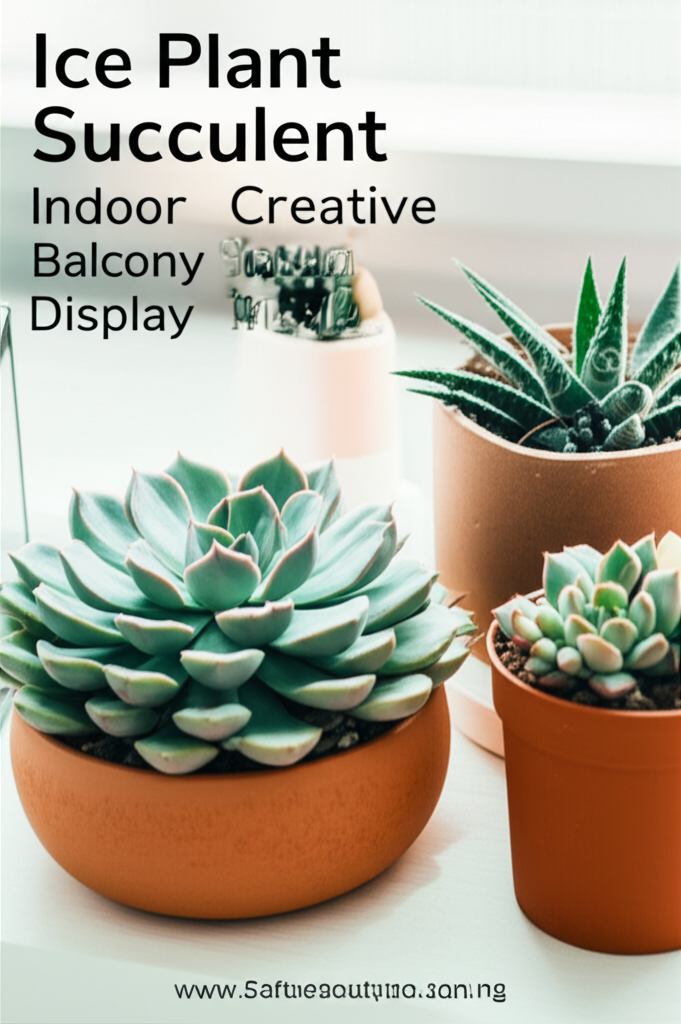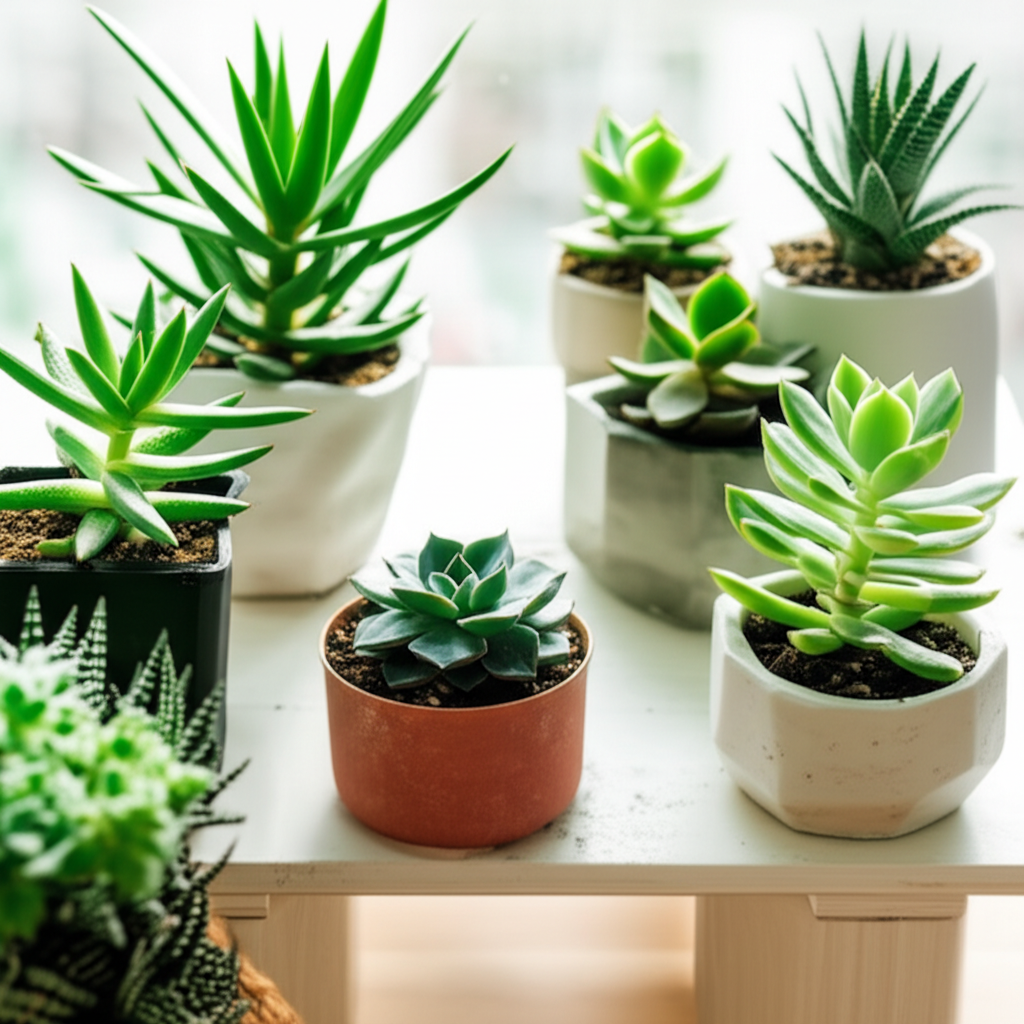Introduction: The Allure of Ice Plants on Your Balcony
Your balcony, often an overlooked extension of your living space, holds immense potential for transformation into a vibrant, living sanctuary. For those seeking low-maintenance beauty and a touch of the exotic, the ice plant succulent (known scientifically as Mesembryanthemum crystallinum, though many popular ornamental varieties fall under the Aizoaceae family) offers a unique and captivating choice. These fascinating plants, characterized by their distinctive, bladder-like leaves that glisten as if covered in frost, are remarkably resilient and adaptable, making them ideal for balcony gardening. This article will delve into creative and inspiring ways to set up an ice plant succulent mini garden display on your balcony, ensuring both aesthetic appeal and plant health.
Understanding Ice Plant Succulents: Key Characteristics

Before diving into display ideas, it’s crucial to understand what makes ice plants so special and how to cater to their needs. Their common name, “ice plant,” derives from the tiny, salt-secreting bladders that cover their leaves and stems, giving them a dewy, crystalline appearance. This adaptation allows them to thrive in arid and saline conditions, which translates to specific care requirements.
Key Characteristics Summary:
- Water Needs: Drought-tolerant. Overwatering is the most common killer. Allow soil to dry out completely between waterings.
- Sunlight Requirements: Full sun to partial shade. Most varieties prefer at least 6 hours of direct sunlight daily.
- Soil: Well-draining is paramount. A succulent or cactus mix is ideal, or amend regular potting soil with perlite or coarse sand.
- Temperature: Prefer warm temperatures. Protect from frost. Many varieties are annuals or tender perennials in colder climates.
- Growth Habit: Many are spreading or trailing, making them excellent for hanging baskets or cascading over containers. Others are more upright.
Balcony Considerations: Optimizing Your Space
Your balcony’s unique environment will dictate the best approach to your ice plant succulent display. Factors like sunlight exposure, wind, and available space are critical.
Assessing Your Balcony Environment:
- Sunlight Mapping: Observe your balcony throughout the day and across seasons. Identify areas that receive morning sun, intense afternoon sun, or dappled shade.
- Wind Exposure: Windy balconies can dry out plants quickly and even damage delicate foliage. Consider windbreaks or selecting more robust varieties.
- Space Limitations: Whether you have a petite Juliet balcony or a sprawling terrace, creative container choices and vertical gardening can maximize your display.
- Weight Restrictions: Be mindful of the weight of your containers, especially if you’re using large pots or many heavy items.
Creative Display Setup Ideas
Now, let’s get to the heart of it – bringing your ice plant succulent vision to life on your balcony.
1. The Cascading Waterfall: Trailing Ice Plants in Hanging Baskets
Many ice plant varieties, such as Delosperma cooperi (Hardy Ice Plant) or certain Lampranthus species, have a naturally trailing habit. This makes them perfect candidates for hanging baskets.
Setup Steps:
- Choose the Right Basket: Opt for a sturdy basket with a good drainage hole. Coconut coir liners are excellent as they allow for good aeration and drainage.
- Select Your Ice Plants: Mix and match different trailing ice plant varieties for texture and color variation. Consider their mature spread to avoid overcrowding.
- Prepare the Soil: Use a well-draining succulent mix.
- Planting: Gently place the ice plants in the basket, allowing their stems to drape over the sides. Don’t overcrowd; give them room to grow.
- Placement: Hang the basket in a location that receives ample sunlight.
2. The Desert Oasis: Mixed Container Displays
Combine various ice plant succulents with other drought-tolerant companions for a visually rich and diverse display.
Companion Plant Suggestions:
- Echeverias: Offer rosette shapes and striking colors.
- Sedums: Many varieties are low-growing and add interesting textures.
- Sempervivums (Hens and Chicks): Extremely hardy and create dense, attractive clusters.
- Aloes and Haworthias: Provide architectural interest and varied leaf forms.
Container Inspiration:
- Terracotta Pots: Classic and porous, they help prevent overwatering.
- Concrete Planters: Modern and durable, they offer a minimalist aesthetic.
- Repurposed Items: Old wooden crates, ceramic bowls, or metal troughs can add unique character. Ensure adequate drainage is added.
3. The Vertical Garden: Maximizing Small Balconies
For limited balcony space, vertical gardening is a game-changer. Wall-mounted planters, tiered shelves, or repurposed pallet gardens can showcase your ice plants beautifully.
Vertical Setup Ideas:
- Wall-Mounted Pockets: Fabric or felt pockets are lightweight and easy to install.
- Tiered Plant Stands: These allow you to arrange multiple pots at different heights.
- Ladder Shelving: A decorative ladder can serve as a tiered display unit.
- Pallet Gardens: Create pockets within a wooden pallet for planting.
4. The Zen Garden: Minimalist and Serene Displays
Embrace simplicity with a minimalist approach. Use a few carefully chosen containers and focus on the unique textures and subtle colors of the ice plants.
Zen Display Elements:
- Monochromatic Color Scheme: Select containers in muted tones like grey, white, or black.
- Natural Materials: Incorporate smooth stones, gravel, or driftwood.
- Focus on Form: Highlight the sculptural qualities of individual ice plants.
- Strategic Placement: Arrange containers with ample negative space to create a sense of calm.
Key Facts and Comparison: Popular Ice Plant Succulent Varieties for Balconies
Choosing the right ice plant variety is crucial for a successful and attractive display. Here’s a comparison of some popular and suitable types for balcony gardening.
| Variety Name | Common Name | Growth Habit | Sunlight Needs | Water Needs | Key Features |
|---|---|---|---|---|---|
| Delosperma cooperi | Hardy Ice Plant | Spreading, mat-forming | Full Sun | Low (drought tolerant) | Bright purple-pink flowers, tolerates some frost |
| Lampranthus spectabilis | Showy Ice Plant | Bushy, semi-trailing | Full Sun | Low (drought tolerant) | Abundant daisy-like flowers in vibrant colors (pink, orange, yellow) |
| Mesembryanthemum crystallinum | Common Ice Plant | Spreading, low-growing | Full Sun to Partial Shade | Moderate (needs more water than some succulents) | Distinctive crystalline bladders, often grown as an annual |
| Aptenia cordifolia | Heartleaf Ice Plant | Trailing, groundcover | Full Sun to Partial Shade | Low (drought tolerant) | Heart-shaped leaves, small pinkish-red flowers |
| Conophytum species | Living Pebbles | Clustering, miniature | Partial Shade (avoid intense afternoon sun) | Very Low (dormant in summer) | Unique, pebble-like appearance, fascinating floral displays |
Planting and Care: Ensuring Thriving Ice Plants
Proper planting techniques and consistent care are essential for the longevity and beauty of your ice plant succulent display.
Steps for Planting:
- Container Preparation: Ensure your chosen container has adequate drainage holes. If necessary, drill additional holes.
- Soil Mix: Fill the container with a well-draining succulent or cactus mix. You can amend standard potting soil with perlite, pumice, or coarse sand at a 2:1 ratio of soil to amendment.
- Planting Depth: Gently remove the ice plant from its nursery pot. Place it in the new container so that the top of the root ball is about an inch below the rim.
- Spacing: Allow adequate space for growth, especially for trailing varieties. Overcrowding can lead to poor air circulation and potential rot.
- Initial Watering: Water thoroughly after planting to settle the soil.
Ongoing Care and Maintenance:
| Aspect | Best Practice | Common Mistakes & Solutions |
|---|---|---|
| Watering | Water thoroughly only when the soil is completely dry. Check by inserting your finger into the soil. Reduce watering significantly in cooler months. | Overwatering: Causes root rot. Allow soil to dry out completely; ensure excellent drainage. Underwatering: Leaves may shrivel. Water deeply but infrequently. |
| Sunlight | Provide at least 6 hours of direct sunlight per day for most varieties. Some prefer protection from intense afternoon sun. | Lack of Sun: Etiolation (stretching and becoming leggy). Move to a sunnier location. Too Much Intense Sun (for sensitive types): Leaf scorch. Provide light afternoon shade. |
| Soil | Use a gritty, fast-draining mix. | Poor Drainage: Leads to root rot. Repot with a better-draining mix. |
| Fertilizing | Generally not required. If desired, use a diluted succulent fertilizer once in the spring during the growing season. | Over-fertilizing: Can burn roots and lead to weak growth. |
| Pests & Diseases | Generally pest-resistant. Watch for mealybugs or aphids. | Pest Infestation: Treat with insecticidal soap or neem oil. Ensure good air circulation. |
| Pruning | Trim back leggy growth to encourage bushier habits and to propagate cuttings. | Neglecting Pruning: Can lead to plants becoming leggy and less aesthetically pleasing. |
Pros and Cons of Ice Plant Succulent Balcony Gardens
Every gardening endeavor has its advantages and disadvantages. Understanding these will help you set realistic expectations.
| Pros | Cons |
|---|---|
| Low Maintenance: Drought-tolerant nature means less frequent watering. | Overwatering Risk: The most common cause of failure. Requires careful monitoring. |
| Unique Aesthetic: The “ice” bladders and vibrant flowers offer a distinctive look. | Frost Sensitivity: Most varieties are not cold-hardy and require protection in winter. |
| Drought Tolerance: Ideal for busy individuals or those in drier climates. | Sunlight Dependency: Requires ample sunlight for best growth and flowering. |
| Versatile Growth Habits: Trailing, upright, and spreading forms allow for diverse display options. | Specific Soil Needs: Requires well-draining soil; standard potting soil can be problematic. |
| Attracts Pollinators: Many varieties produce abundant flowers that attract bees and butterflies. | Potential for Invasive Behavior (in some regions): Certain Mesembryanthemum species can be invasive in mild climates. Choose non-invasive cultivars or be mindful of your local environment. |
Creative Styling Tips for Maximum Impact
Elevate your ice plant succulent display from simple to spectacular with these styling tips.
- Color Coordination: Match the colors of your containers to the hues of the ice plant flowers or foliage for a cohesive look.
- Texture Play: Combine ice plants with different leaf textures (e.g., smooth, fuzzy, spiky) for visual interest.
- Height Variation: Use tiered stands or varying pot heights to create depth and dimension.
- Themed Displays: Create a “coastal” theme with sand-colored pots and shells, or a “desert” theme with rocks and gravel.
- Focal Points: Use a particularly striking ice plant or a uniquely shaped container as a central focal point.
Conclusion: Your Balcony, Your Ice Plant Oasis
Transforming your balcony into a haven of shimmering beauty with ice plant succulents is an achievable and rewarding endeavor. By understanding their unique needs, considering your balcony’s environment, and embracing creative display ideas, you can cultivate a miniature succulent garden that offers year-round interest and a touch of botanical magic. Whether you opt for cascading displays, vibrant mixed containers, or minimalist zen arrangements, the resilience and unique charm of ice plants are sure to make your balcony a standout space. So, gather your containers, select your specimens, and get ready to let your ice plant succulent garden bloom!


